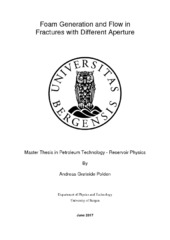Foam Generation and Flow in Fractures with Different Aperture
Master thesis
Permanent lenke
https://hdl.handle.net/1956/16061Utgivelsesdato
2017-06-20Metadata
Vis full innførselSamlinger
Sammendrag
This experimental thesis investigate foam generation and flow properties in real, rough-walled fractures, through impermeable marble core plugs. A range of fracture apertures was investigated, denoted open, partially open or tight, and represents a variation is system permeability. The foam evaluation was performed by co-injection of N2 gas and surfactant solution and measuring the differential pressure at different boundary conditions. A comprehensive experimental investigation of foam generation and behavior in fractures was conducted with a total of 42 co-injections for a range of conditions. Differential pressure and visual observations of produced fluids, combined with calculation of mobility reduction factor (MRF) and apparent viscosity, confirmed that foam generated and reduced gas mobility in rough-walled fractures. In fracture systems with smooth surfaces, without foam generation sites, foam generation was not observed for the same conditions and system dimensions. Local changes in sweep efficiency were visualized in-situ during co-injections with positron emission tomography (PET) combined with computed tomography (CT). An aqueous tracer was added to the co-injections to determine local aqueous phase saturations. Direct comparison between co-injections with or without a foaming agents demonstrated a significant sweep efficiency increase with foam, combined with a local reduction in liquid saturation. A critical superficial velocity for foam generation was determined in the fracture system, below which foam was not observed. Foam behavior in partially open fractures was similar to foam in porous media, with a notable exception: high-quality foam behaved similarly in fractures as in porous media, but low-quality foam, however, deviated from porous media observations. Low-quality foam was dependent on both liquid and gas velocities in fractures, compared with porous media, where low-quality foam only depends on gas velocities. A significant hysteresis effect is observed in experiments with varying gas fraction. Different pressure trends are seen when comparing results performed from gas fraction 1 to 0 with experiments conducted from gas fraction 0 to 1.
